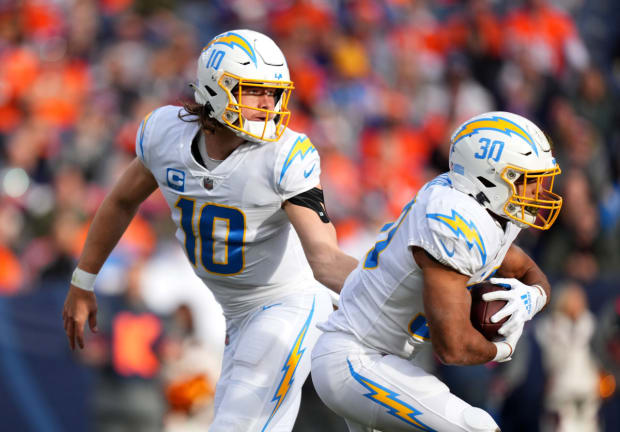The Chargers have allowed Austin Ekeler to seek a trade, and while I understand your first instinct may be to Google whether Ekeler and Aaron Rodgers are personal friends and what the Jets’ running back depth chart looks like, I can promise you this will be a bigger deal in December than we’re making it out to be right now.
Ekeler, 27, is one of the most valuable running backs in the NFL and has been instrumental in the development of Justin Herbert. I am far less interested in the fact that he’s scored 38 touchdowns over the past two seasons than the fact that he’s been responsible for almost 15% of the passing first downs logged by Herbert in that same time, in addition to 99 more first downs added on the ground.
As we wrote before the start of last season, the proliferation of Vic Fangio–style umbrella defenses has put us in a golden age of checkdown running backs. As a result, we begged the Panthers not to trade Christian McCaffrey and the Giants not to deal Saquon Barkley. To be honest, we didn’t consider the Chargers parting ways with Ekeler because his presence seemed to be so obviously and intimately tied to Herbert’s progress. The Giants, who raced to get a deal done with quarterback Daniel Jones in part because they’d already utilized the franchise tag for Barkley, and the 49ers, who traded almost the entirety of a draft mid-round to acquire McCaffrey, seem to agree.
McCaffrey, at the height of his receiving powers, was responsible for more than 50% of the passing first downs logged by the Carolina Panthers, but that was during the tail end of the Cam Newton era. (Newton was passing for fewer than 200 first downs per season and dealing with a decline in arm strength due to a shoulder injury.) So, those numbers appear a bit more outsized.
In a modern offense designed to spread the ball around, Ekeler’s first down share is somewhat unheard of, almost a full 5% better than Leonard Fournette during his best year with the checkdown happy Tom Brady. Ekeler’s proficiency after the catch is also eye opening. No running back caught as many balls as he did in 2022, and no running back was within a yard of his average reception distance, either. Ekeler caught his passes on average 1.1 yards behind the line of scrimmage and racked up nearly 900 yards after the catch. He saved one of the best quarterbacks in the NFL from stressing his arm multiple times per game, and he generated easy completions that kept drives flowing.

Ron Chenoy/USA TODAY Sports
Eli Manning, Drew Brees and Ben Roethlisberger have all led the league in completions to running backs at some point; the availability of easy completions correlates with some of the most efficient seasons in the careers of Hall of Fame quarterbacks.
Consider this lineup of three running backs. We have combined their best two receiving seasons:
- Player 1: 77.8 catch%, 6.9 scrimmage yards per touch, 8.7 yards per target, 82 receiving first downs
- Player 2: 83.8 catch%, 6 scrimmage yards per touch, 7 yards per target, 99 receiving first downs
- Player 3: 84.75 catch%, 6.1 scrimmage yards per touch, 7.45 yards per target, 78 receiving first downs
Ekeler is player three. The first two? Marshall Faulk and McCaffrey, respectively. Ekeler is competitive in almost every major category, has a better scrimmage yards per touch than McCaffrey and has a better yards per target as well. Ekeler has, in two seasons with Herbert, almost as many receiving first downs as Faulk had while playing with the Greatest Show on Turf.
Alright, you say. I’ve somewhat convinced you that Ekeler is better than you thought he was. But paying running backs is bad. He is no longer as valuable if he’s making more than the $6.25 million he’s due in 2023. We’ll just draft a few guys and make up the difference.
To that, I’d ask you to take a look at this class. While deep, there aren’t more than a very small handful of players who could project to take on that kind of workload. Joshua Kelley caught 56% of his passes with the Chargers last year despite a similar average starting point to Ekeler. Larry Rountree III, in a very limited sample size, caught 100% of his passes but only received two targets. Isaiah Spiller only received three.
Ekeler is not just another running back. He is a focal point of an offense that, regardless of who is calling plays, needs a capable checkdown option to limit the stress on Herbert, who is already one of the most taxed quarterbacks on a down-to-down basis in the NFL.
While we’d normally celebrate netting some kind of mid-round pick for a running back on the wrong side of 26, this is not one of those times.
!["[T]he First and Fifth Amendments Require ICE to Provide Information About the Whereabouts of a Detained Person"](https://images.inkl.com/s3/publisher/cover/212/reason-cover.png?w=600)






